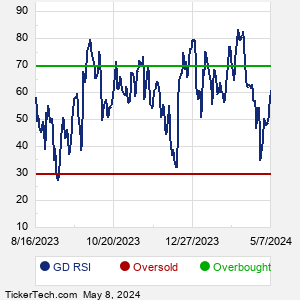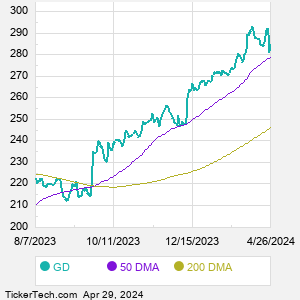General Dynamics is an aerospace and defense company. Co.'s operating segments include: Aerospace, which consists of Co.'s Gulfstream that designs, develops and manufactures aircraft and Jet Aviation that provides a suite of aircraft services for aircraft owners and operators; Marine Systems, which designs and builds nuclear-powered submarines and provides in surface combatant and auxiliary ship design and construction; Combat Systems, which is a manufacturer and integrator of land combat solutions; and Technologies, which provides a range of services, technologies and products to a market that seeks solutions combining electronic hardware with software.
When researching a stock like General Dynamics, many investors are the most familiar with Fundamental Analysis — looking at a company's balance sheet, earnings, revenues, and what's happening in that company's underlying business. Investors who use Fundamental Analysis to identify good stocks to buy or sell can also benefit from GD Technical Analysis to help find a good entry or exit point. Technical Analysis is blind to the fundamentals and looks only at the trading data for GD stock — the real life supply and demand for the stock over time — and examines that data in different ways. One of these ways is called the Relative Strength Index, or RSI. This popular indicator, originally developed in the 1970's by J. Welles Wilder, looks at a 14-day moving average of a stock's gains on its up days, versus its losses on its down days. The resulting GD RSI is a value that measures momentum, oscillating between "oversold" and "overbought" on a scale of zero to 100. A reading below 30 is viewed to be oversold, which a bullish investor could look to as a sign that the selling is in the process of exhausting itself, and look for entry point opportunities. A reading above 70 is viewed to be overbought, which could indicate that a rally in progress is starting to get crowded with buyers. If the rally has been a long one, that could be a sign that a pullback is overdue. |



